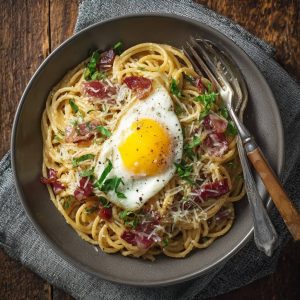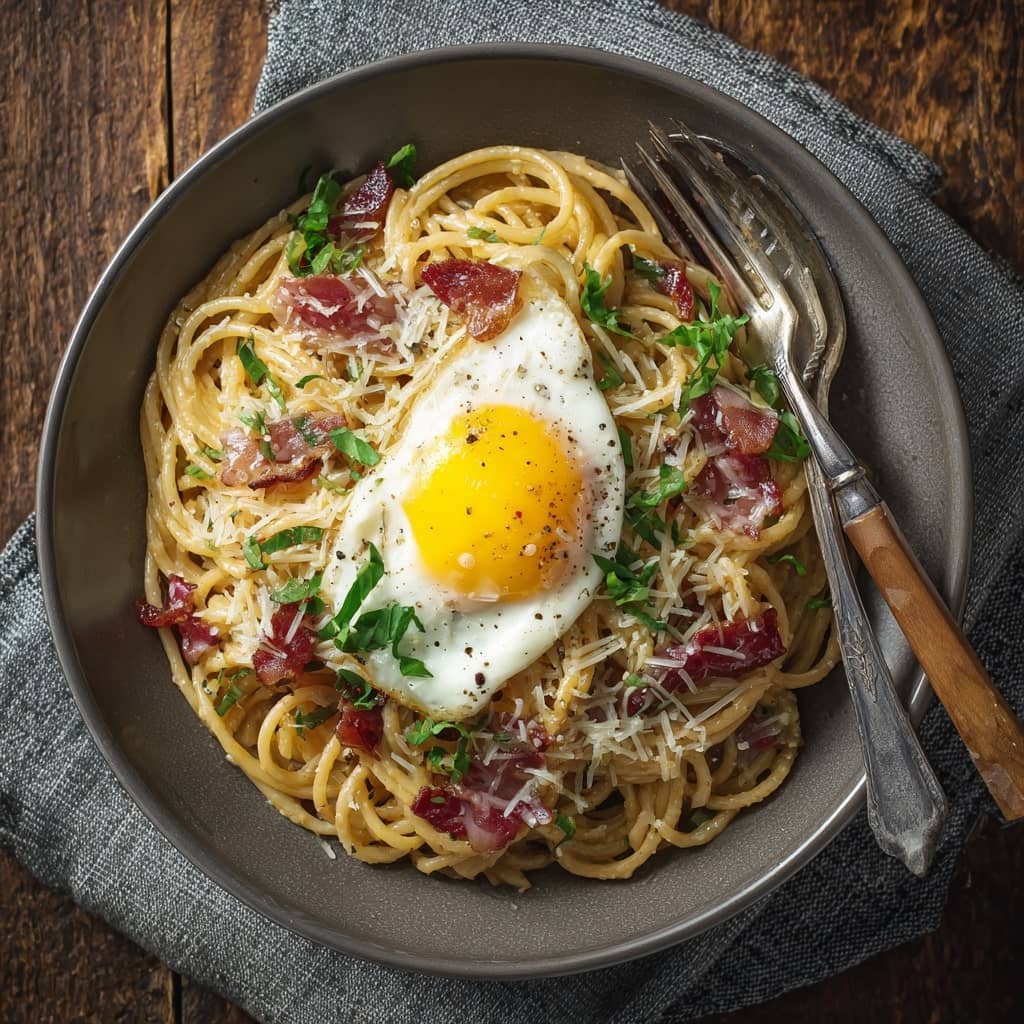Spaghetti Carbonara with a Twist is a creative reinvention of the classic Italian pasta dish, combining the traditional silky, egg-based sauce with bold, unexpected ingredients for a unique flavor experience. This variation retains the soul of the original recipe—al dente spaghetti tossed with eggs, cheese, pancetta or bacon, and black pepper—but enhances it with modern additions like vegetables, cream, smoked proteins, or non-traditional cheeses to add layers of depth and richness. Loved by home cooks and chefs alike, this revamped carbonara offers a new culinary adventure while paying homage to its Roman roots. Whether you’re looking to impress guests or simply elevate your weeknight dinner routine, this fusion-style carbonara is proof that classic dishes can be reimagined without losing their heart. Its versatility and ease of preparation make it a go-to recipe for anyone seeking indulgent comfort with a gourmet flair, appealing to both traditionalists and modern palates.
The history of carbonara is rooted in mid-20th-century Italy, with the most widely accepted origin placing it in Rome. Unlike many ancient Italian dishes with medieval or Renaissance origins, carbonara’s rise is relatively recent. It’s believed to have emerged around World War II, possibly as a result of American soldiers bringing bacon and powdered eggs to Italy, which local cooks then incorporated with pasta. The original carbonara is made with guanciale (cured pork cheek), pecorino Romano cheese, eggs, and black pepper—no cream, garlic, or onions as often found in international adaptations. As the dish spread beyond Italy, especially to the United States and the UK, creative liberties were taken to suit local tastes, leading to the “twists” seen today. These innovations range from adding peas and mushrooms to using smoked salmon, plant-based proteins, or even truffle oil. Though purists may insist on preserving the traditional preparation, the evolution of carbonara represents how global influence and experimentation can breathe new life into time-honored recipes.
Ingredients Breakdown
– 1 lb (450g) spaghetti: The base of the dish, cooked to al dente for proper texture
– 4 oz pancetta or thick-cut bacon: Provides a savory, salty punch; traditionally guanciale is used
– 2 whole eggs + 2 egg yolks: Creates the creamy, rich sauce without needing cream
– 1 cup grated Parmesan or Pecorino Romano: Gives the dish a salty, umami depth
– 2 tbsp olive oil: Helps cook the pancetta and adds flavor
– 1 tsp freshly cracked black pepper: Essential for spice and aroma
– Optional twist ingredients: sautéed mushrooms, peas, spinach, sun-dried tomatoes, smoked salmon, caramelized onions, or truffle oil
– Salt for pasta water: Enhances flavor from within
– Fresh parsley or basil (optional): For garnish and color contrast
Step-by-Step Recipe
- Boil the spaghetti in a large pot of salted water until al dente according to package directions. Reserve 1 cup of the starchy pasta water, then drain the pasta.
- Cook the pancetta or bacon in a skillet over medium heat until crispy, about 5-7 minutes. Remove from heat and set aside, keeping the rendered fat in the pan.
- In a separate bowl, whisk together the eggs, egg yolks, grated cheese, and black pepper until fully combined and smooth. This mixture will become the sauce.
- Add the hot spaghetti directly into the skillet with the pancetta fat (off the heat to avoid scrambling the eggs). Mix quickly to coat the noodles evenly.
- Slowly pour in the egg-cheese mixture, tossing vigorously with tongs or two forks to create a creamy sauce. If too thick, gradually add reserved pasta water until you reach a silky consistency.
- Stir in your twist ingredients such as sautéed mushrooms, spinach, or sun-dried tomatoes. Fold them into the pasta evenly so every bite is flavorful.
- Serve immediately, topped with extra cheese, black pepper, and herbs if desired. Optionally drizzle with truffle oil for an elevated finish.
Tips for the Perfect
Use room-temperature eggs for smoother emulsification with the hot pasta. Never add the egg mixture over direct heat—this avoids scrambling. Use freshly grated cheese instead of pre-packaged for better melting and flavor. Render pancetta or bacon slowly for maximum crispness and flavor. If adding vegetables, make sure they are well-drained or sautéed to avoid a watery sauce. Reserve pasta water as it’s essential for adjusting the sauce’s texture and helps it cling to the noodles. Toss the pasta constantly while adding the egg mixture to create a creamy, custardy coating without clumps. For an extra layer of umami, a small amount of miso paste can be added to the sauce—this is especially good in vegetarian variations. Always taste and adjust for salt at the end, especially since cheeses and cured meats are already salty.
Variations and Customizations
– Vegetarian: Replace pancetta with sautéed mushrooms, caramelized onions, or smoked tofu for a meatless version
– Seafood twist: Add smoked salmon or shrimp for a pescatarian-friendly meal
– Creamy carbonara: Add a splash of cream or mascarpone for extra richness (though non-traditional)
– Spicy version: Include red pepper flakes or chopped chili for heat
– Green twist: Stir in spinach, peas, or kale for added nutrition and color
– Herbed: Add fresh herbs like thyme, basil, or parsley to enhance aroma
– Cheesy: Blend different cheeses such as Asiago, Fontina, or Gruyère for complexity
– Truffle carbonara: A drizzle of truffle oil or a sprinkle of truffle salt transforms this dish into a gourmet delight
– Low-carb: Substitute spaghetti with zucchini noodles or shirataki noodles for a keto-friendly version
Health Considerations and Nutritional Value
Traditional carbonara is high in protein from the eggs and pancetta and rich in calcium from the cheese. However, it’s also high in fat, cholesterol, and sodium, especially when made with bacon and extra cheese. Twisted versions can improve the nutritional profile depending on the additions: vegetables like spinach and peas increase fiber, antioxidants, and vitamins; using whole wheat or legume-based pasta boosts fiber and protein; and substituting plant-based proteins or low-fat cheese can reduce saturated fat intake. Still, this dish is best enjoyed in moderation or adapted to fit dietary needs. A single serving typically contains around 500-700 calories, 25-35g fat, 40-50g carbs, and 20-25g protein, depending on the version. For a lighter version, consider halving the cheese, using egg whites, and loading it with greens.
FAQ
Can I use regular bacon instead of pancetta? Yes, thick-cut bacon works well and is easier to find, though pancetta is more traditional.
Is cream supposed to be in carbonara? Traditionally no, but many modern twists include cream for added richness.
How do I avoid scrambling the eggs? Remove the pan from heat before adding the egg mixture, and toss vigorously to combine.
Can I make it vegetarian? Absolutely. Use mushrooms, caramelized onions, or smoked tofu in place of pancetta.
How long does it keep? Store leftovers in the fridge for up to 3 days. Reheat gently to avoid drying out the sauce.
Can I freeze carbonara? It’s not recommended, as the egg-based sauce can separate upon thawing.
What’s the best pasta for carbonara? Spaghetti is traditional, but fettuccine, bucatini, or linguine also work well.
Can I use a different cheese? Yes. While Pecorino Romano is classic, Parmesan, Asiago, or even smoked cheeses can be used for twists.
Is it safe to eat raw eggs in carbonara? The heat of the pasta cooks the eggs gently, creating a safe, creamy sauce when prepared correctly.
Can I make it dairy-free? Use nutritional yeast and a dairy-free cheese alternative, and omit traditional cheese.

Spaghetti Carbonara with a Twist
Ingredients
- – 3 liters water
- – ½ tablespoon rock salt
- – 300 grams 10 oz spaghetti, or use spaghettoni, rigatoni, or mezze maniche
- – 210 grams 5.3 oz guanciale, cut into small strips
- – 6 tablespoons Pecorino cheese
- – 3 egg yolks
- – Freshly ground black pepper
Instructions
- Modern Spaghetti Carbonara includes a few subtle updates, but the process starts the same way: bring a large pot of water to a boil for your pasta.
- Once boiling, add ½ tablespoon of rock salt.
- Cook the pasta according to the package instructions, but remove it from the water one minute before it’s fully done—this keeps it al dente and allows it to finish cooking in the pan.
- Slice the guanciale into small strips, making sure each piece has a layer of fat on both ends with the meat in the center.
- Place a large frying pan over low to medium heat. For the best modern spaghetti carbonara, add the guanciale to the pan and let it cook slowly so it releases its own flavorful oil.
- Allow the guanciale to gently simmer, becoming crispy on the outside while staying tender inside.
- Grab two small mixing bowls and separate the egg yolks from the whites. Set the whites aside. Into the bowl with the yolks, add 6 tablespoons of Pecorino cheese, a key ingredient in this updated version.
- Using a spatula, thoroughly combine the egg yolks and Pecorino cheese until a thick, creamy paste forms.
- When the pasta is nearly done, reserve a cup of the starchy cooking water—it’s crucial for the sauce.
- Drain the pasta and transfer it directly into the pan with the guanciale over low heat. Immediately pour in half the reserved pasta water and stir continuously with tongs, allowing the liquid to reduce and coat the pasta.
- When most of the water has evaporated, add a small additional splash of pasta water and then turn off the heat.
- Add the egg yolk and Pecorino mixture, stirring vigorously until the sauce becomes silky and creamy, coating every strand.
- Finish by adding a generous amount of freshly cracked black pepper and give the pasta one final mix before plating.
- E ora si mangia, from Vincenzo’s Plate—enjoy your modern take on a Roman classic!

